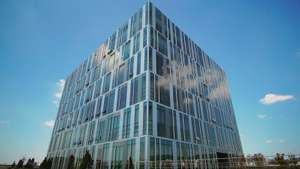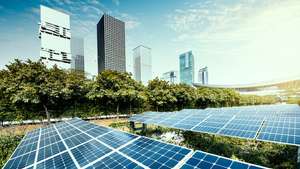
Algorithm of the system approach to estimation of environmental processes during the reconstruction of housing in the city of Kyiv.
 Dmytro Varavin 1*,
Dmytro Varavin 1*,
1 Kyiv National University of Construction and Architecture, address: Povitroflotsky Avenue, 31, Kyiv, 03680 Ukraine
Received: 03/10/2018, Accepted: 03/18/2018, Available online: 03/20/2018.
DOI: https://doi.org/10.32557/useful-2-1-2018-0004
HDL: http://hdl.handle.net/20.500.12334/45
*Corresponding author: e-mail: d.varavin@icloud.com
Under a creative commons license. Volume 2, Issue 1, 2018, pages: 30-40.
Author Keywords: environmental assessment algorithm, reconstruction, systems approach.
ABSTRACT
The algorithm of the system approach to estimation of environmental processes during the reconstruction of housing in the city of Kyiv is described in this article. The problem of using resources by the real estate sector is defined and the ways of its solution are presented (main indicators and elements of ecological processes of reconstruction FS, EE, RP, OM, CE are defined). The process of forming a team of specialists in the means of identifying the initial data of the project, tools, and methods of selecting the team is built. The main elements of building the reconstruction process (methodology, organizational structure, means of communication) are revealed. The process of environmental assessment at different stages of the object reconstruction is proposed (pre-project stage, design stage, construction and installation stage, commissioning and maintenance phase of the facility). The prerequisites are laid for the derivation and justification of comfort living indices based on the parameters determining the degree and level of ecological compatibility of the reconstruction (energy efficiency, water use efficiency, location of the reconstruction object, transport accessibility, etc.).
Introduction
Today, we use the equivalent of 1.5 Earth to meet the resource requirements used in everyday life and lead to waste generation. This measurement of the carrying capacity of our planet means that the recovery of the Earth takes about 18 months, not 12 (calendar year). If current trends continue, then by expert estimates, by 2030, we need the equivalent of our two planets.
The process of turning resources into waste is faster than resources can be restored again, and this leads to an ecological catastrophe. This is a global problem for our planet, which must be addressed in a comprehensive manner in every sector of the economy. [1]
Buildings play an important role in sustainable development through their construction, life cycle, functioning and development patterns. As the world's population continues to grow, the process of building and renovating buildings will increase to meet the needs of the growing population of our planet. For instance, from the evaluation of the real estate sector for the US, it follows that two-thirds of the objects that will be built by 2050, these will be the objects that we are building today. It is very important to understand and evaluate which objects are being built and where we are building them. [2]
1.1. Analysis of recent research and publications.
Ukrainian specialists analyzed the directions of the formation of standard housing in the period from 1955 to 1990 and its reconstruction, studied issues that help to better consider some aspects of renovation of typical buildings: L. S. Abramov, L. М. Barmashyna, L. G. Bachinska, L. І. Belova, S. G. Buravchenko, І. P. Gnes, А. P. Kalinichenko, V. І. Knysh, E.E. Klushnichenko, О. І. Kolodrubska, Т. S. Kravchunovska, D. V. Kuznetsov, G. V. Litoshenko, V. P. Makhrin, L. H. Muliar, M. V. Omelianenko, О. М. Panko, О.L. Pidgornyi, О. V. Sergeichuk, U. V. Skliarenko, О. S. Sleptsov, М. А. Shvets, О. U. Scheglova. [3]
The relevance and significance of the issues of the reconstruction of residential buildings is raised in the works of M.M. Zherbin, V.I. Bolshakov and other scientists. [5,6] One of the most promising ways of recreating the housing stock of Ukraine is its reconstruction. Despite the existing methods of assessing and justifying the need and effectiveness of the reconstruction of the housing stock, there to date is insufficient attention to this issue [3−5]. According to the evaluation of the "Planet Obolon" Agency, the following types of houses exist and require reconstruction in Kyiv (Table 1):

Considering and classifying the residential sector of Kyiv, the following segments are distinguished: «Pre-revolutionary» segment is 12% share and is located in the central districts of Kyiv. Quite often these houses are monuments of history and/or architecture. Their peculiarity consists in the fact that for comfortable living they are suitable only after major repairs, since they equipped with outdated communal engineering networks, there is worn design, applied construction materials are manufactured using old technologies and not suitable for safe operation; «Stalinka» is 14% share and have classical forms (right angles, modest decor), ceramic and silicate bricks are used, reinforced concrete or combined floors, 2-4 apartments are located on the floor. Communal engineering systems, in most cases decently function for their age; «Old panel» is 14% share. This segment is characterized by a small area of premises (apartments) with uncomfortable (not comfortable) architectural solutions. Heat and sound insulation of residential buildings in this segment are quite low. The comfort, environmental friendliness, and reliability of living in these buildings is a big question; «Typical panel» is 8% share and by and large almost does not differ in matters of comfort, environmental friendliness and quality of residence from the segment "Old panel". It is located mainly in the "sleeping" districts of Kyiv; «Improved typical panel» is 7% share and reaches 22 floors in height. The walls of the dwelling of this segment are made of prefabricated reinforced concrete elements. Such houses are located exclusively in the "sleeping" districts of the city; «Old brick» is 23% share. The houses of this segment have better heat and sound insulation in comparison with the reinforced concrete walls because the ceramic brick has a much higher degree of thermal insulation compared to reinforced concrete.
The old building regulations dictated the construction of houses made of ceramic bricks with external walls in the thickness not less than half a meter. This segment is observed in virtually all districts of the city; «Improved brick» is 7% share and differs from "Soviet" buildings with improved architectural solutions, and also advanced technologies and materials of that period were applied at their erection; «Ukrainian panel» is 3% share. For their construction are used panel blocks and they are located in the "sleeping" districts of Kyiv. This segment generates housing one of the last Ukrainian generations, as well as the home of this segment is well designed, besides, they are successfully adapted to implement on their squares own design abilities and ideas; «Ukrainian brick» is 12% share and is the most progressive segment of residential buildings. The houses are equipped with modern communications, have an autonomous communal system. Bearing structures are made of bricks.
Based on long-term studies of data table 1 it can be concluded that in modern conditions of energy saving and ecological security construction projects has become one of the most pressing issues in Kyiv. Development of resource-saving technologies occupies leading positions in the world's scientific trends. American studies have demonstrated that buildings use 72% of electricity and 39% of the total energy consumption of the country. In addition, the construction industry produces about 38 % of CO2 emissions, 30% of waste and consumes 14 % of drinking water, which in turn makes a significant contribution to global processes of climate change. [1] Developing an algorithm of the system approach for the evaluation of environmental processes of reconstruction of housing stock in the city of Kyiv it is possible to find solutions to this issue.
Presentation of the main material of the study
Reconstruction of buildings is a complex process, requiring an integrated approach at all stages of implementation. The fundamental factors of reconstruction are the volume of investment, environmental and climatic conditions, from which the volume and scale of reconstruction shall be determined. The development of the algorithm of the system approach for the evaluation of environmental processes of reconstruction of housing stock in the city of Kyiv is reduced to determining the main indicators and directions in this area. These include:
- Functional suitability of the reconstruction object (FS) – the value with which the reconstruction object provides functions that satisfy specified requirements when implemented in the specified conditions;
- Efficiency of execution of reconstruction processes (EE) – efficiency which depends on the resources used under given conditions;
- Reliability of reconstruction processes (RP) – the limiting factor at which the reconstruction object performs the assigned functions under given conditions and time interval;
- Degree of operation and management of the reconstruction object (OM) – an indicator of the effectiveness and efficiency of which the object will be managed by the end user;
- Convenience and ease of handling the reconstruction object (CE) – An indicator of automation and compliance with specified parameters.
Based on the indicators proposed above, the system approach for the evaluation of environmental processes of reconstruction of housing stock in the city of Kyiv can be represented by a generalized scheme (Fig. 1).

To implement the presented approach a team of specialists shall be formed (Fig.2, where ID – initial data of the project; IM – instruments and methods of a team selection, R - result) who have specialized education and sufficient professional experience in the implementation of multi-task and multi-level construction projects in the field of civil construction able to formulate and implement all the criteria and variables that provide them for the task of determining environmental and economic efficiency and rank their significance with a theoretical justification.

An important element in this process is the used methodology, the organizational structure of the project and the use of modern communication methods as the main elements of building the reconstruction process (Fig. 3).

The methodology for the evaluation of environmental processes of reconstruction involves a set of standards, methodologies, instructions, regulations, model projects used by the organizational structure, taking into account modern means of communication, processing and storing information, to enhance the environmental and economic effect of this process.
To build an algorithm for the evaluation of environmental processes of reconstruction, it is necessary to take into account the following important parameters that determine the degree and level of ecological compatibility of the reconstruction of residential buildings and structures, namely energy efficiency (application and introduction of modern energy saving methods and technologies, introduction of renewable energy systems, use of energy consumption meters, regular involvement of specialists for the evaluation of embedded technologies, training of operating personnel and awareness of tenants, etc.), water use efficiency, location of the reconstruction object and transport accessibility, indoor environmental quality (view from the window, acoustics, lighting, thermal comfort, indoor air quality, level of environmental friendliness of materials, etc.), materials and resources (life cycle of building materials, waste management plan, environmental monitoring), that can later be used to determine the comfort indices for living in reconstructed buildings. The algorithm for the evaluation of environmental processes of reconstruction in the city of Kyiv can be represented as follows (Fig. 4).
When developing an algorithm for the evaluation of environmental processes it is necessary to orient and move towards the "green house". The results of the move to the "green house" will give the residents and the city as a whole significant advantages, such as saving financial resources, increasing market value, improving the quality of indoor air, creating a healthy internal environment that certainly would positively influence health, reduce maintenance costs, and much more.

One of the key processes at all stages of the reconstruction of a residential object is to ensure the quality of the indoor environment, on which depends the health of the population, working capacity, the cost to repair and restore the building and mechanical systems Level of occupancy/rental and in general the economic indicators of the region where the reconstructed object is located. The process of environmental evaluation at different stages of the reconstruction project is presented in Fig.5.

Moving towards the "green house" it is necessary to rely on the world experience in the field of "sustainable construction and reconstruction", and to lay the following technologies in the projects: technologies for saving energy costs. According to USGBC reports, saving energy resources by 30% - 60% will save the family budget by thousands of dollars for several years already; technology to improve the quality of indoor air. 90% of their time people spend in confined spaces, being exposed to air pollutants, such as volatile organic compounds (VOCs), phenol and formaldehyde, sulfur dioxide, separation from structures, furniture and interiors when the room is heated and cooled, and others. Foreseen in the projects of reconstruction of the housing sector the existing technologies such as cleaning air with photo catalysis, for example, will significantly reduce the amount of harmful substances in the air, improve the ventilation of premises, which as a result will lead to a significant reduction in many diseases including life-threatening diseases such as cancer, cardiac infarction, stroke.
Conclusions
Implementation of the algorithm of the systematic approach for evaluation of the environmental processes of the reconstruction of housing stock in the city of Kyiv will not only effectively solve tasks, but also methodologically take unmistakable solutions for each case, formulate all possible matching variables (for example, the introduction of modern energy-saving methods, environmental materials, etc., which meet the world quality standards). A team of specialists in the field of environmental construction will determine the necessary criteria and variables, and will carry out all the necessary types of supervisions and inspections at all stages of reconstruction, which will improve the quality of life, improve the health of the population, will contribute to the economic performance of the region and, in general, to the ecological situation on the planet.
References
[1] USGBC, “Reference guide for interior design and construction LEED ID+C” v.4, Washington, DC. 2016. – 489 p.
[2] Ewing, R., K. Bartholomew, S. Winkleman, J. Walters, and D. Chen, “Growing Cooler: The Evidence on Urban Development and Climate Change” (Washington, DC: Urban Land Institute, 2008), p. 8, https://smartgrowthamerica.org/documents/growingcoolerCH1.pdf. https://doi.org/10.1080/01944360802540364
[3] Novosad, Yryna (2016). Specific techniques of reconstruction of typical houses 1970-1980-ies. Management of Development of Complex Systems, 26, 146 – 152. : http://nbuv.gov.ua/UJRN/Urss_2016_26_23
[4] SBR В.3.2-2-2009. “Residential buildings. The reconstruction and overhaul”. – Kyiv: Мinistry for Regional Development, Building and Housing of Ukraine, 2009. – 23 p. – Access mode: http://dbn.at.ua/load/normativy/dbn/1-1-0-333
[5] SBR А.2.2-3-2004. “Composition, the procedure for the development, coordination and approval of project documentation for construction”. – Kyiv: Мinistry for Regional Development, Building and Housing of Ukraine, 2004. – 35 p. – Access mode: http://dbn.at.ua/load/normativy/dbn/1-1-0-333.
[6] М. М. Zherbin, V. І. Bolshakov, “A new concept of reconstruction and modernization of existing residential buildings”. Construction of Ukraine. – 1998. - № 2. - 19−23.
[7] А. Shvets, N. V. Savitskiy,V. I. Bolshakov, “Development of structural systems for the reconstruction of small buildings”. Bulletin of the Academy of Construction of Ukraine. – Kyiv. – 1997. - P. 87−92. – Access mode: http://pgasa.dp.ua
Please cite as: D.Varavin “Algorithm of the system approach to estimation of environmental processes during the reconstruction of housing in the city of Kyiv.” USEFUL online journal, vol. 2, no. 1, pp. 30–40, March 2018. DOI: https://doi.org/10.32557/useful-2-1-2018-0004








Comments